University Report: Rational Decision Making and Employee Motivation
VerifiedAdded on 2021/04/19
|7
|1413
|106
Report
AI Summary
This report explores rational decision-making within an organizational context, emphasizing its significance in addressing workplace challenges. It highlights the importance of effective decision-making by managers to resolve issues and improve organizational outcomes. The report outlines a six-stage decision-making framework, including problem identification, choosing the best decision process, developing alternatives, selecting the optimal solution, implementation, and evaluation. The primary problem addressed is the lack of employee motivation, and the report analyzes potential solutions such as rewards, recognition, and emotional support. It emphasizes the importance of providing employees with opportunities for growth, setting clear goals, and enhancing benefits. The report concludes by stressing the role of motivation in driving organizational success, including increased sales and profit, and the need for continuous evaluation of the implemented strategies.
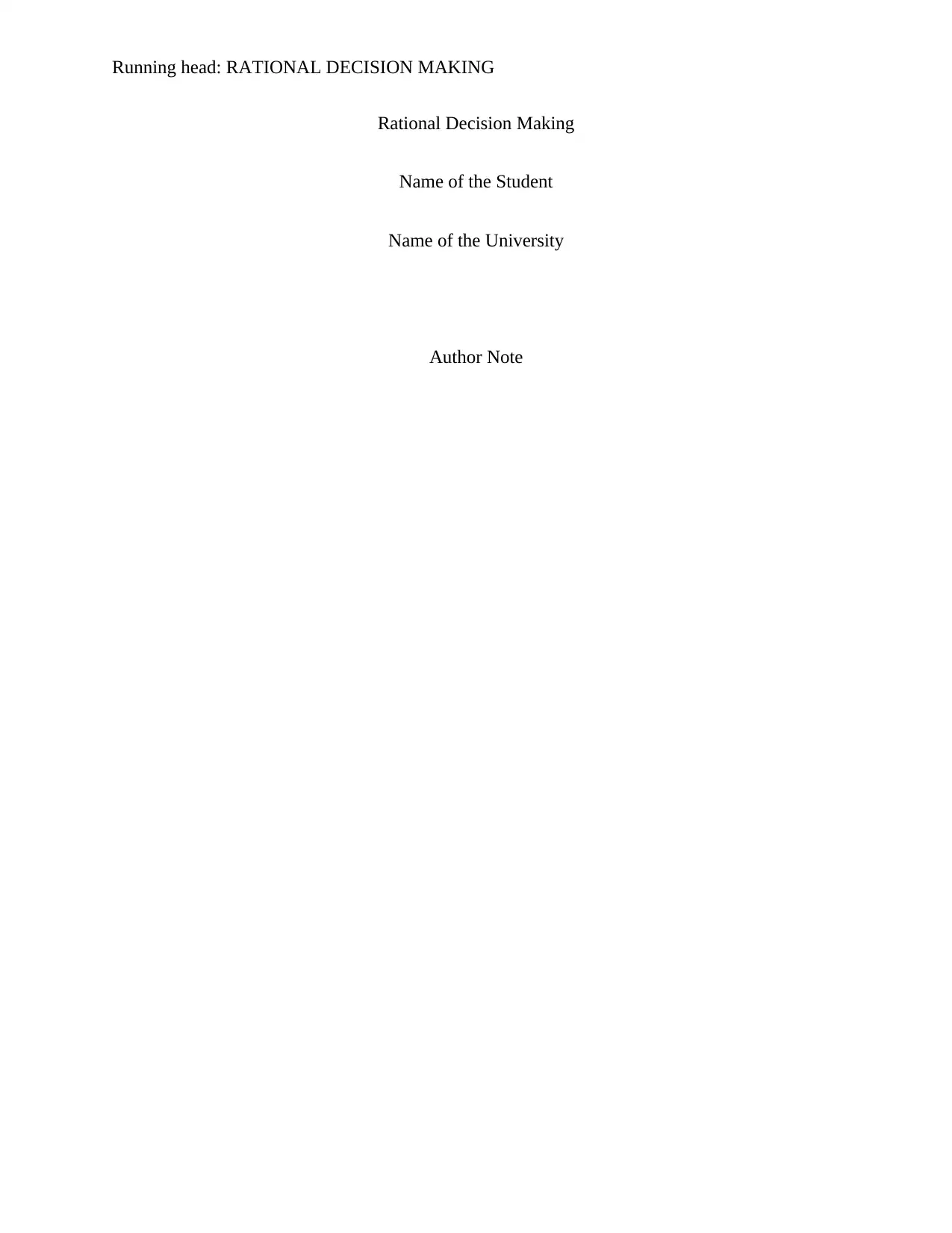
Running head: RATIONAL DECISION MAKING
Rational Decision Making
Name of the Student
Name of the University
Author Note
Rational Decision Making
Name of the Student
Name of the University
Author Note
Paraphrase This Document
Need a fresh take? Get an instant paraphrase of this document with our AI Paraphraser
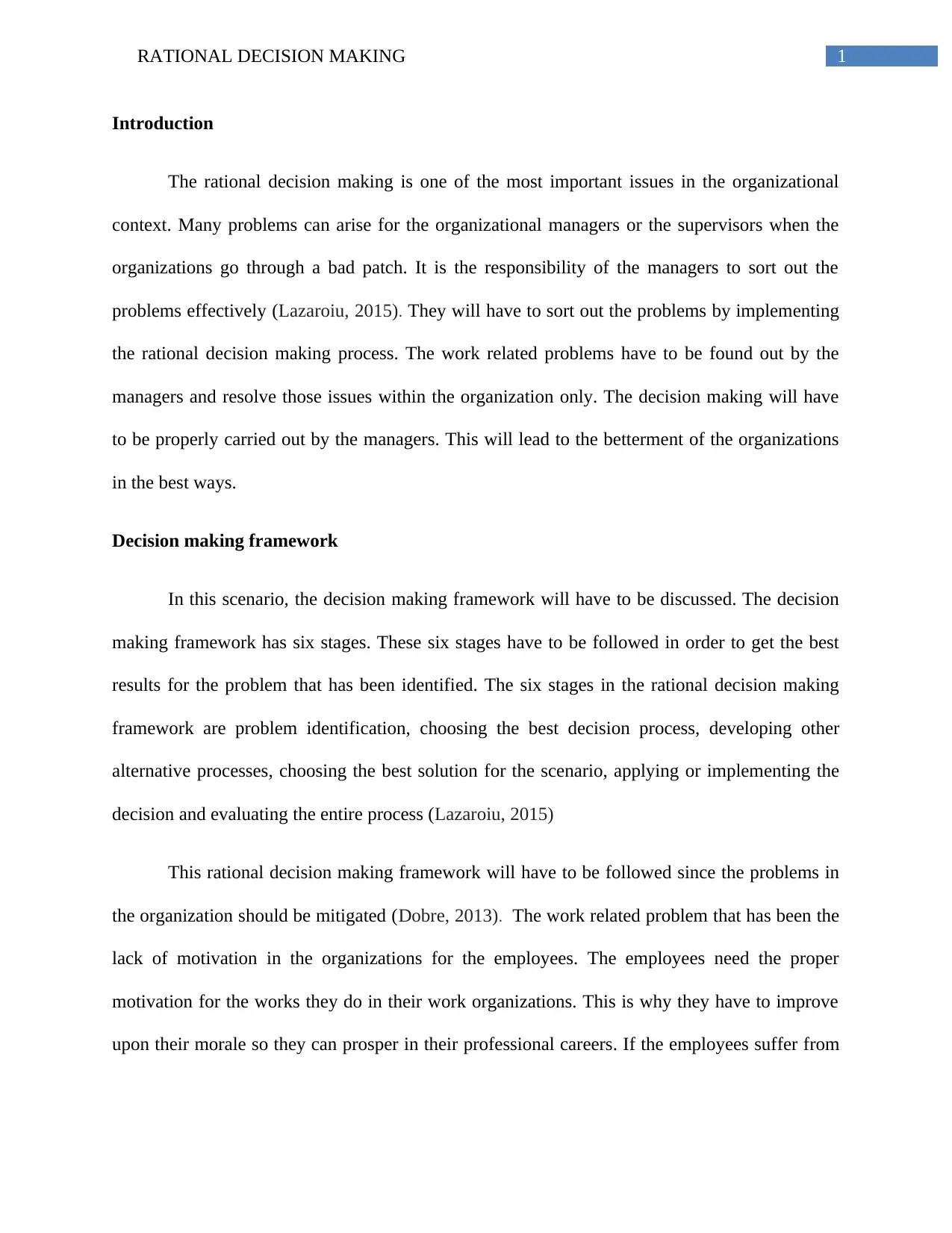
1RATIONAL DECISION MAKING
Introduction
The rational decision making is one of the most important issues in the organizational
context. Many problems can arise for the organizational managers or the supervisors when the
organizations go through a bad patch. It is the responsibility of the managers to sort out the
problems effectively (Lazaroiu, 2015). They will have to sort out the problems by implementing
the rational decision making process. The work related problems have to be found out by the
managers and resolve those issues within the organization only. The decision making will have
to be properly carried out by the managers. This will lead to the betterment of the organizations
in the best ways.
Decision making framework
In this scenario, the decision making framework will have to be discussed. The decision
making framework has six stages. These six stages have to be followed in order to get the best
results for the problem that has been identified. The six stages in the rational decision making
framework are problem identification, choosing the best decision process, developing other
alternative processes, choosing the best solution for the scenario, applying or implementing the
decision and evaluating the entire process (Lazaroiu, 2015)
This rational decision making framework will have to be followed since the problems in
the organization should be mitigated (Dobre, 2013). The work related problem that has been the
lack of motivation in the organizations for the employees. The employees need the proper
motivation for the works they do in their work organizations. This is why they have to improve
upon their morale so they can prosper in their professional careers. If the employees suffer from
Introduction
The rational decision making is one of the most important issues in the organizational
context. Many problems can arise for the organizational managers or the supervisors when the
organizations go through a bad patch. It is the responsibility of the managers to sort out the
problems effectively (Lazaroiu, 2015). They will have to sort out the problems by implementing
the rational decision making process. The work related problems have to be found out by the
managers and resolve those issues within the organization only. The decision making will have
to be properly carried out by the managers. This will lead to the betterment of the organizations
in the best ways.
Decision making framework
In this scenario, the decision making framework will have to be discussed. The decision
making framework has six stages. These six stages have to be followed in order to get the best
results for the problem that has been identified. The six stages in the rational decision making
framework are problem identification, choosing the best decision process, developing other
alternative processes, choosing the best solution for the scenario, applying or implementing the
decision and evaluating the entire process (Lazaroiu, 2015)
This rational decision making framework will have to be followed since the problems in
the organization should be mitigated (Dobre, 2013). The work related problem that has been the
lack of motivation in the organizations for the employees. The employees need the proper
motivation for the works they do in their work organizations. This is why they have to improve
upon their morale so they can prosper in their professional careers. If the employees suffer from
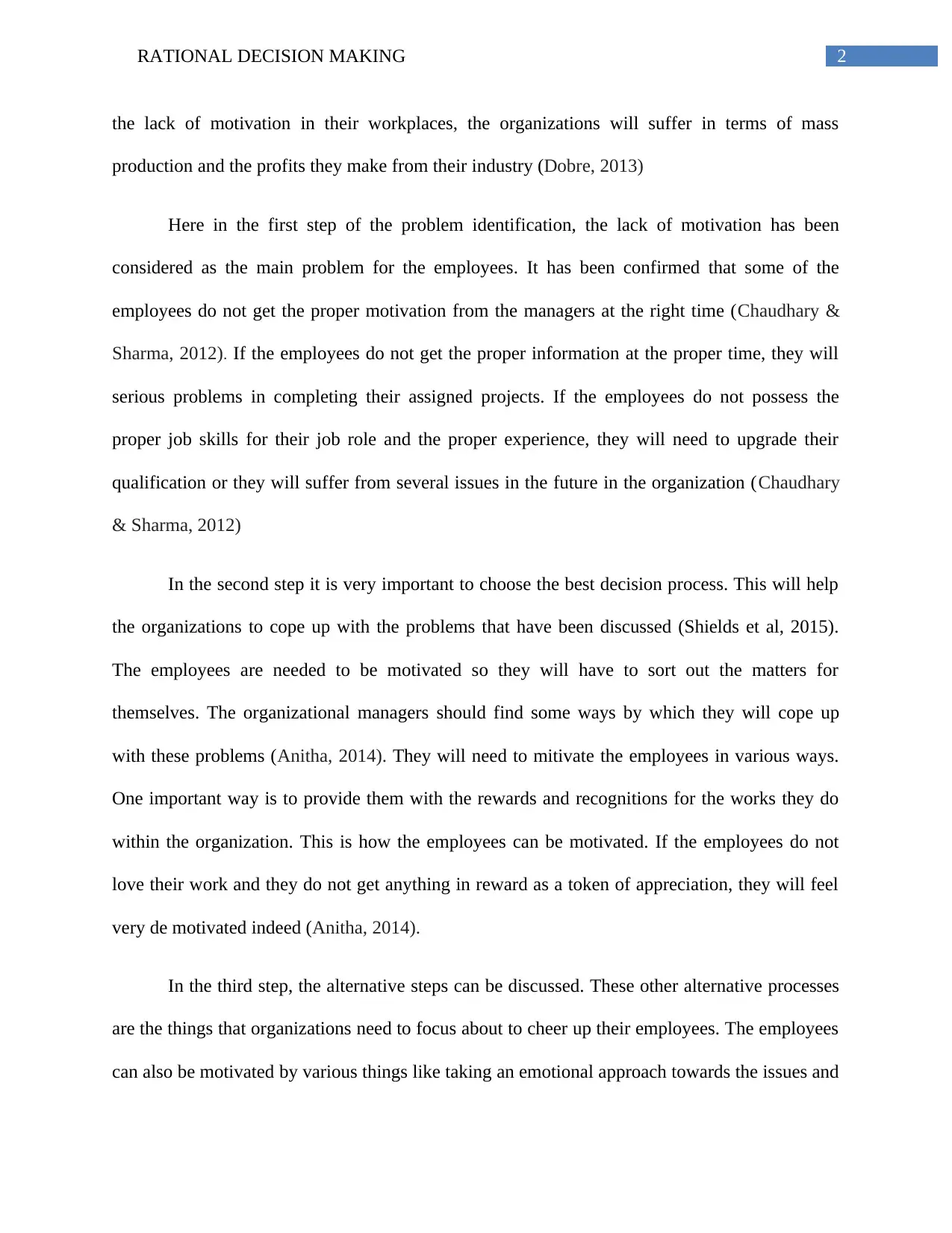
2RATIONAL DECISION MAKING
the lack of motivation in their workplaces, the organizations will suffer in terms of mass
production and the profits they make from their industry (Dobre, 2013)
Here in the first step of the problem identification, the lack of motivation has been
considered as the main problem for the employees. It has been confirmed that some of the
employees do not get the proper motivation from the managers at the right time (Chaudhary &
Sharma, 2012). If the employees do not get the proper information at the proper time, they will
serious problems in completing their assigned projects. If the employees do not possess the
proper job skills for their job role and the proper experience, they will need to upgrade their
qualification or they will suffer from several issues in the future in the organization (Chaudhary
& Sharma, 2012)
In the second step it is very important to choose the best decision process. This will help
the organizations to cope up with the problems that have been discussed (Shields et al, 2015).
The employees are needed to be motivated so they will have to sort out the matters for
themselves. The organizational managers should find some ways by which they will cope up
with these problems (Anitha, 2014). They will need to mitivate the employees in various ways.
One important way is to provide them with the rewards and recognitions for the works they do
within the organization. This is how the employees can be motivated. If the employees do not
love their work and they do not get anything in reward as a token of appreciation, they will feel
very de motivated indeed (Anitha, 2014).
In the third step, the alternative steps can be discussed. These other alternative processes
are the things that organizations need to focus about to cheer up their employees. The employees
can also be motivated by various things like taking an emotional approach towards the issues and
the lack of motivation in their workplaces, the organizations will suffer in terms of mass
production and the profits they make from their industry (Dobre, 2013)
Here in the first step of the problem identification, the lack of motivation has been
considered as the main problem for the employees. It has been confirmed that some of the
employees do not get the proper motivation from the managers at the right time (Chaudhary &
Sharma, 2012). If the employees do not get the proper information at the proper time, they will
serious problems in completing their assigned projects. If the employees do not possess the
proper job skills for their job role and the proper experience, they will need to upgrade their
qualification or they will suffer from several issues in the future in the organization (Chaudhary
& Sharma, 2012)
In the second step it is very important to choose the best decision process. This will help
the organizations to cope up with the problems that have been discussed (Shields et al, 2015).
The employees are needed to be motivated so they will have to sort out the matters for
themselves. The organizational managers should find some ways by which they will cope up
with these problems (Anitha, 2014). They will need to mitivate the employees in various ways.
One important way is to provide them with the rewards and recognitions for the works they do
within the organization. This is how the employees can be motivated. If the employees do not
love their work and they do not get anything in reward as a token of appreciation, they will feel
very de motivated indeed (Anitha, 2014).
In the third step, the alternative steps can be discussed. These other alternative processes
are the things that organizations need to focus about to cheer up their employees. The employees
can also be motivated by various things like taking an emotional approach towards the issues and
⊘ This is a preview!⊘
Do you want full access?
Subscribe today to unlock all pages.

Trusted by 1+ million students worldwide
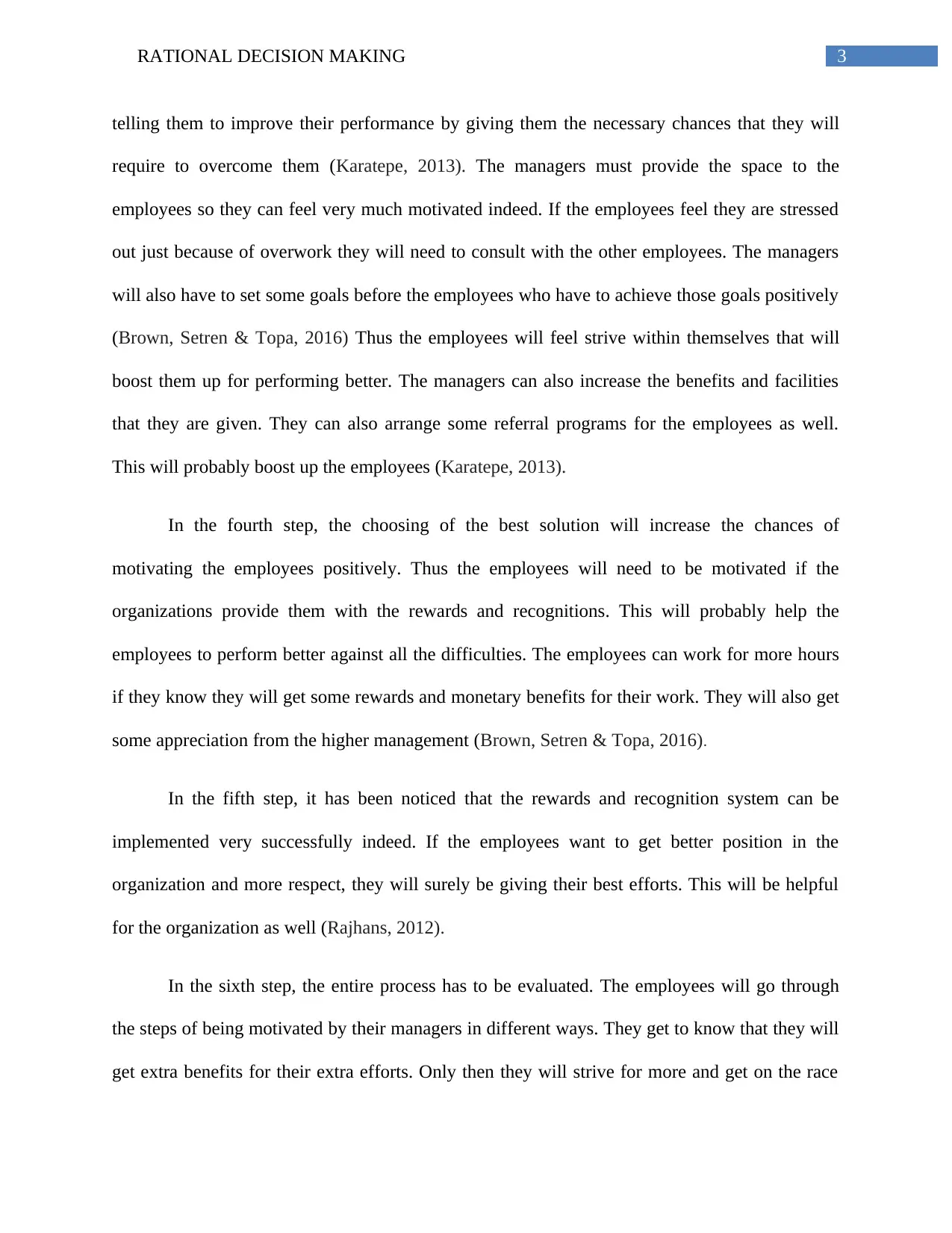
3RATIONAL DECISION MAKING
telling them to improve their performance by giving them the necessary chances that they will
require to overcome them (Karatepe, 2013). The managers must provide the space to the
employees so they can feel very much motivated indeed. If the employees feel they are stressed
out just because of overwork they will need to consult with the other employees. The managers
will also have to set some goals before the employees who have to achieve those goals positively
(Brown, Setren & Topa, 2016) Thus the employees will feel strive within themselves that will
boost them up for performing better. The managers can also increase the benefits and facilities
that they are given. They can also arrange some referral programs for the employees as well.
This will probably boost up the employees (Karatepe, 2013).
In the fourth step, the choosing of the best solution will increase the chances of
motivating the employees positively. Thus the employees will need to be motivated if the
organizations provide them with the rewards and recognitions. This will probably help the
employees to perform better against all the difficulties. The employees can work for more hours
if they know they will get some rewards and monetary benefits for their work. They will also get
some appreciation from the higher management (Brown, Setren & Topa, 2016).
In the fifth step, it has been noticed that the rewards and recognition system can be
implemented very successfully indeed. If the employees want to get better position in the
organization and more respect, they will surely be giving their best efforts. This will be helpful
for the organization as well (Rajhans, 2012).
In the sixth step, the entire process has to be evaluated. The employees will go through
the steps of being motivated by their managers in different ways. They get to know that they will
get extra benefits for their extra efforts. Only then they will strive for more and get on the race
telling them to improve their performance by giving them the necessary chances that they will
require to overcome them (Karatepe, 2013). The managers must provide the space to the
employees so they can feel very much motivated indeed. If the employees feel they are stressed
out just because of overwork they will need to consult with the other employees. The managers
will also have to set some goals before the employees who have to achieve those goals positively
(Brown, Setren & Topa, 2016) Thus the employees will feel strive within themselves that will
boost them up for performing better. The managers can also increase the benefits and facilities
that they are given. They can also arrange some referral programs for the employees as well.
This will probably boost up the employees (Karatepe, 2013).
In the fourth step, the choosing of the best solution will increase the chances of
motivating the employees positively. Thus the employees will need to be motivated if the
organizations provide them with the rewards and recognitions. This will probably help the
employees to perform better against all the difficulties. The employees can work for more hours
if they know they will get some rewards and monetary benefits for their work. They will also get
some appreciation from the higher management (Brown, Setren & Topa, 2016).
In the fifth step, it has been noticed that the rewards and recognition system can be
implemented very successfully indeed. If the employees want to get better position in the
organization and more respect, they will surely be giving their best efforts. This will be helpful
for the organization as well (Rajhans, 2012).
In the sixth step, the entire process has to be evaluated. The employees will go through
the steps of being motivated by their managers in different ways. They get to know that they will
get extra benefits for their extra efforts. Only then they will strive for more and get on the race
Paraphrase This Document
Need a fresh take? Get an instant paraphrase of this document with our AI Paraphraser
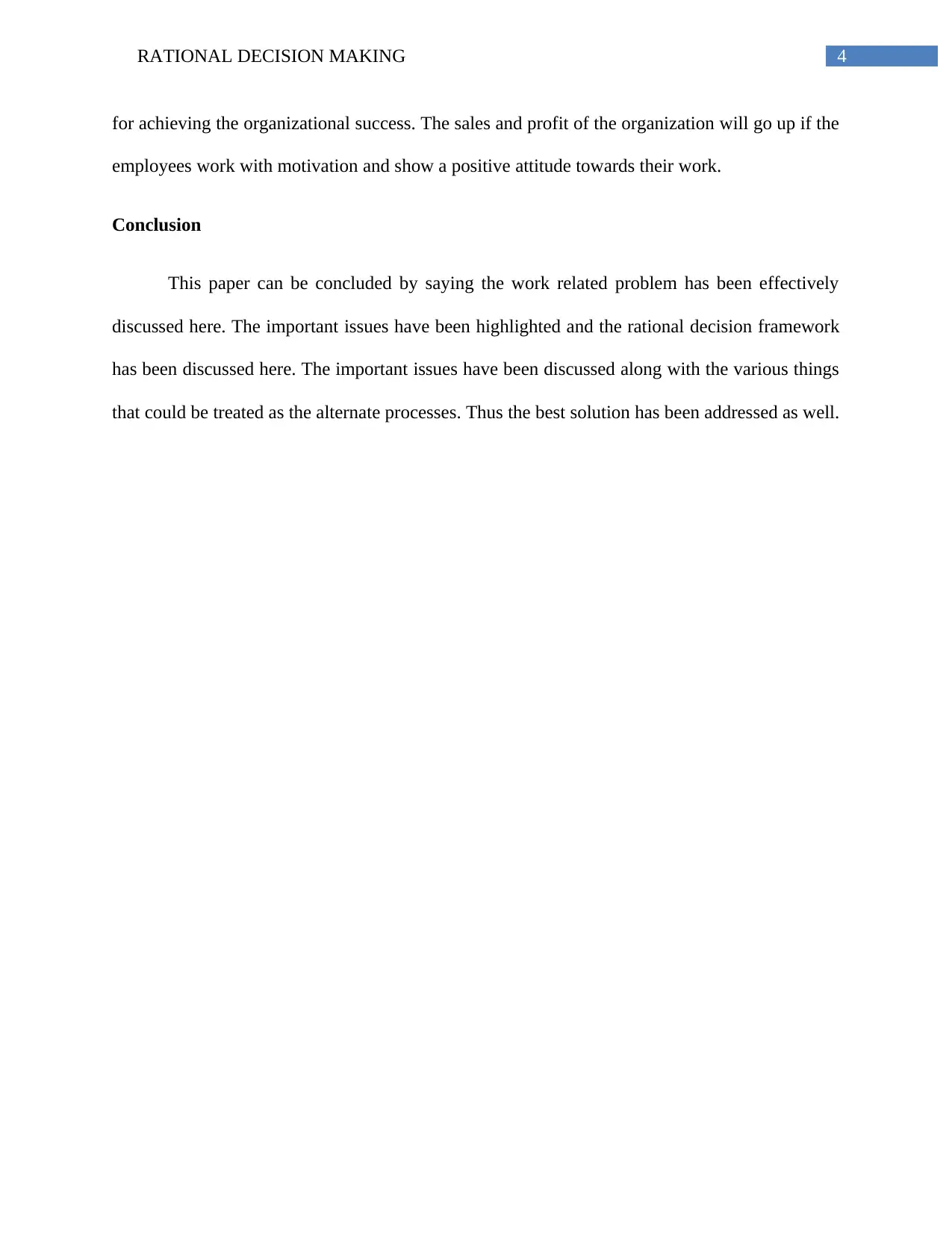
4RATIONAL DECISION MAKING
for achieving the organizational success. The sales and profit of the organization will go up if the
employees work with motivation and show a positive attitude towards their work.
Conclusion
This paper can be concluded by saying the work related problem has been effectively
discussed here. The important issues have been highlighted and the rational decision framework
has been discussed here. The important issues have been discussed along with the various things
that could be treated as the alternate processes. Thus the best solution has been addressed as well.
for achieving the organizational success. The sales and profit of the organization will go up if the
employees work with motivation and show a positive attitude towards their work.
Conclusion
This paper can be concluded by saying the work related problem has been effectively
discussed here. The important issues have been highlighted and the rational decision framework
has been discussed here. The important issues have been discussed along with the various things
that could be treated as the alternate processes. Thus the best solution has been addressed as well.
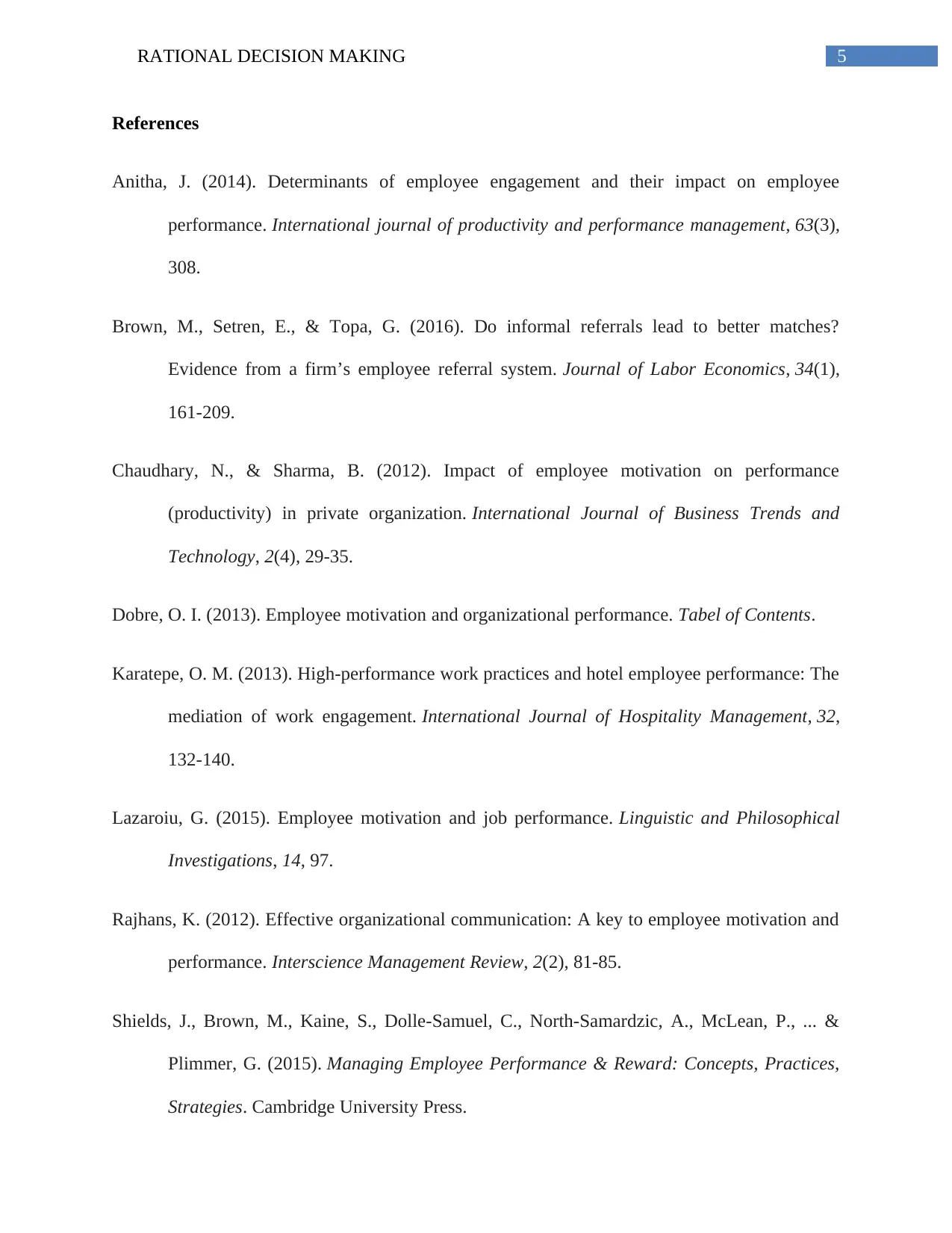
5RATIONAL DECISION MAKING
References
Anitha, J. (2014). Determinants of employee engagement and their impact on employee
performance. International journal of productivity and performance management, 63(3),
308.
Brown, M., Setren, E., & Topa, G. (2016). Do informal referrals lead to better matches?
Evidence from a firm’s employee referral system. Journal of Labor Economics, 34(1),
161-209.
Chaudhary, N., & Sharma, B. (2012). Impact of employee motivation on performance
(productivity) in private organization. International Journal of Business Trends and
Technology, 2(4), 29-35.
Dobre, O. I. (2013). Employee motivation and organizational performance. Tabel of Contents.
Karatepe, O. M. (2013). High-performance work practices and hotel employee performance: The
mediation of work engagement. International Journal of Hospitality Management, 32,
132-140.
Lazaroiu, G. (2015). Employee motivation and job performance. Linguistic and Philosophical
Investigations, 14, 97.
Rajhans, K. (2012). Effective organizational communication: A key to employee motivation and
performance. Interscience Management Review, 2(2), 81-85.
Shields, J., Brown, M., Kaine, S., Dolle-Samuel, C., North-Samardzic, A., McLean, P., ... &
Plimmer, G. (2015). Managing Employee Performance & Reward: Concepts, Practices,
Strategies. Cambridge University Press.
References
Anitha, J. (2014). Determinants of employee engagement and their impact on employee
performance. International journal of productivity and performance management, 63(3),
308.
Brown, M., Setren, E., & Topa, G. (2016). Do informal referrals lead to better matches?
Evidence from a firm’s employee referral system. Journal of Labor Economics, 34(1),
161-209.
Chaudhary, N., & Sharma, B. (2012). Impact of employee motivation on performance
(productivity) in private organization. International Journal of Business Trends and
Technology, 2(4), 29-35.
Dobre, O. I. (2013). Employee motivation and organizational performance. Tabel of Contents.
Karatepe, O. M. (2013). High-performance work practices and hotel employee performance: The
mediation of work engagement. International Journal of Hospitality Management, 32,
132-140.
Lazaroiu, G. (2015). Employee motivation and job performance. Linguistic and Philosophical
Investigations, 14, 97.
Rajhans, K. (2012). Effective organizational communication: A key to employee motivation and
performance. Interscience Management Review, 2(2), 81-85.
Shields, J., Brown, M., Kaine, S., Dolle-Samuel, C., North-Samardzic, A., McLean, P., ... &
Plimmer, G. (2015). Managing Employee Performance & Reward: Concepts, Practices,
Strategies. Cambridge University Press.
⊘ This is a preview!⊘
Do you want full access?
Subscribe today to unlock all pages.

Trusted by 1+ million students worldwide

6RATIONAL DECISION MAKING
1 out of 7
Related Documents
Your All-in-One AI-Powered Toolkit for Academic Success.
+13062052269
info@desklib.com
Available 24*7 on WhatsApp / Email
![[object Object]](/_next/static/media/star-bottom.7253800d.svg)
Unlock your academic potential
Copyright © 2020–2025 A2Z Services. All Rights Reserved. Developed and managed by ZUCOL.





